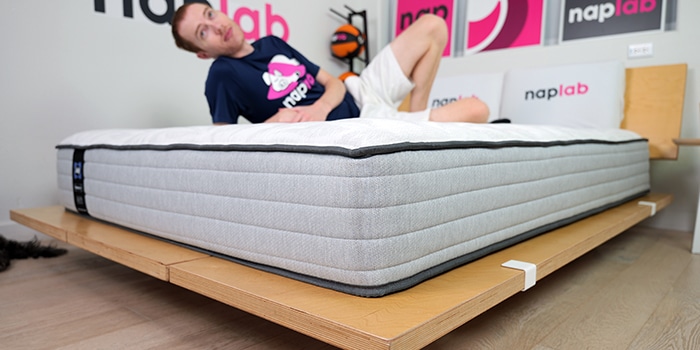
Best For
- Low price under $600 for a queen mattress
- Fast material response time, fully recovered by 0.6 seconds
- Great edge support for sitting or lying
Considerations
- Poor cooling and high levels of heat retention
- Poor pressure relief, thinner comfort layer than average
- Relatively short 90-night trial and return fee of $175 if you don’t love it
Our Verdict
The Sealy Posturepedic Spring mattress is a 11.5″ coil mattress that uses a pocketed coil support base with a poly foam comfort layer, and plush 2.0″ quilted cover.
This mattress has deep sinkage and moderate levels of bounce.
It is available in two firmness levels—medium soft and medium. We tested the medium version and found it to have a medium-firm feel (6 out of 10 on the firmness scale). We would estimate the medium soft version to be closer to a medium, 5 out of 10.
In our performance tests, the Sealy Spring has an overall score of 7.05, ranking in the bottom 2% of all mattresses tested to date. This is an extremely low performance score and there are virtually no instances where I would recommend this mattress to anyone.
Although the low price of only $599 for a queen can look attractive to sleepers on a tight budget, there are many other options I would recommend before this Sealy. See our best affordable mattress guide for those recommendations.
Type: Coil
Firmness: Medium (5) and Medium-Firm (6)
Best For: Stomach or Back Sleepers
In This Review
Performance Tests | Firmness | Support & Sleeping Positions | Design | Materials | Comparisons | FAQs
Performance Tests
At NapLab, we put each mattress to the test.
We test 10 different factors that impact the performance, comfort, and feel of the mattress. We then take the results of that test and compare to every mattress we’ve tested to date.
Check out the full performance table below to see how this mattress ranks:
| Factor | Sealy Posturepedic Spring | Average |
|---|---|---|
| Overall Score | 7.05 | 8.55 |
| Price (Queen) | $599 | $1,057 (Coil only) |
| Cooling – Score | 5.0 | 8.7 |
| Sinkage – Depth | 2.47″ | 2.15″ |
| Sinkage – Feel | Deep | Moderate |
| Motion Transfer – Score | 8.0 | 8.2 |
| Motion Transfer – Acceleration | 9.52 m/s² | 8.79 m/s² |
| Response Time – Score | 9.7 | 8.9 |
| Response Time – Mostly Recovered | 0.2 sec. | 0.4 sec. |
| Response Time – Fully Recovered | 0.6 sec. | 0.9 sec. |
| Bounce – Height | 9.68″ | 9.51″ |
| Bounce – Feel | Moderate | Moderate |
| Edge Support – Score | 9.4 | 8.6 |
| Edge Support – Sitting | 3.25″ | 4.04″ |
| Edge Support – Lying | Excellent | Good |
| Sex – Score | 8.4 | 8.4 |
| Pressure Relief – Score | 5.0 | 8.7 |
| Comfort Layer Thickness | 3.5″ | 4.1″ |
| Mattress Thickness | 11.5″ | 12.0″ |
| Off-Gassing – Score | 9.2 | 8.2 |
| Off-Gassing – Smell | Strong | Strong |
| Off-Gassing – Days | 3 days | 6 days |
| Company – Score | 6.4 | 8.8 |
| Trial | 90 nights | 177 nights |
| Warranty | 10 years | 25% have lifetime warranties, average of other 75% of mattresses is 13 years |
How is Sealy Posturepedic Spring Different?
The Sealy Posturepedic Spring is an 11.5″ coil mattress with an overall performance that is significantly below average, but also a price tag that is below average as well.
Advantages
Aside from the price, other advantages of the Posturepedic Spring mattress include a very fast material response time and better-than-average edge support. Off-gassing is also faster than average, although this tends to be a minor factor for most sleepers.
Neutral Factors
Neutral factors include deep sinkage and moderate levels of bounce. Both of these factors are considered neutral since sleeper preferences can vary and these factors could easily become advantages or disadvantages, depending on the feel you’re looking for.
Sex performance is also neutral since the 8.4 performance score is right at the average level.
Disadvantages
Disadvantages of the Sealy Spring mattress include poor cooling with higher levels of heat retention, higher levels of motion transfer, and poor levels of pressure relief.
This mattress has 3.5″ of comfort material, only 0.5″ less than the average, but the quality of materials is really what hurts this mattress more than anything.

Cooling Test
The Sealy Posturepedic Spring has poor cooling. During our tests, I felt a significant degree of heat retention around my body.
Baseline Temp.
77.5° F
Max Temp.
93.3° F
Ending Temp.
81.2° F
Max Temp.
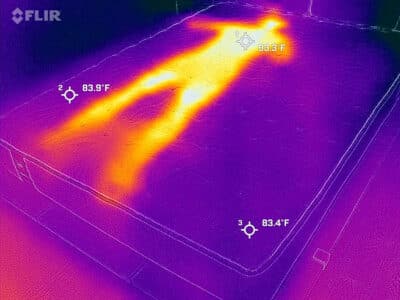
Ending Temp
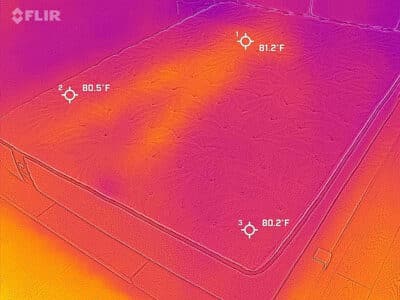
- Baseline Temperature – the temperature of the mattress before anyone lies on it
- Maximum Temperature (0 minute) – the temperature of the mattress after lying on it for 15 minutes
- Ending Temperature (5 minute) – the temperature of the mattress after being lied upon and having no one on it for 5 minutes
The mattress feels quite warm and does not seem to breathe well. The mattress is equipped with a 2.0” quilted cover and a 1.5” poly foam comfort layer. Neither of these layers look or feel particularly high quality.
The 1.5” poly foam is very stiff and has a noticeable “crunchiness” to the feel. We’ve experienced this foam (or at least foams that are substantially similar) in other Sealy mattresses we’ve tested, including the Sealy Posturepedic Hybrid, Sealy Posturepedic Plus RidgeCrest II, and Sealy Posturepedic Carver.
In my view, this foam is simply incredibly basic. It is notably worse quality compared to many other poly foam types we’ve tested.
In addition, it is also the likely reason for much of the cooling and pressure relief issues we experienced on the Posturepedic Spring and other Sealy Posturepedic mattresses we’ve previously tested.
In our objective temperature tests, we measured a max surface level temperature of 93.3° F. This is 3.6° more than the average of 89.7° F, based on all of our tests to date.
Heat Dissipation Over Time
When we consider the combination of objective data, my subjective experiences, and an analysis of the materials, I’m confident in my view that cooling is poor.

Sinkage Test
The Sealy Posturepedic Spring has deep sinkage. During our tests, we measured a pressure point sinkage depth of 2.47″. This is 0.32″ more sinkage than the average sinkage depth of 2.15″, based on all of our tests to date.
Sinkage Depth
2.47″
Sinkage Feel
Deep
Body Contour
Slight
The level of sinkage is documented in the image below.

The mattress creates a more generalized body-contouring hug. Despite the deeper level of sinkage, the foams don’t hug or contour to the exact shape of the body in the same way that a memory foam or many other types of poly foam will.
Even so, between the quilted cover and 1.5” foam comfort layer, the mattress does still create a modest level of hug. It’s just not the dramatic and exacting memory foam hug. Instead, the mattress has a more classic coil type of a feel.
This is neither good nor bad, but it is a specific feel. Those who prefer the feel of coils and more traditional mattresses are more likely to enjoy the feel.
Motion Transfer Test
The Sealy Posturepedic Spring has a low level of motion transfer. During our tests, we measured a total acceleration range of 9.52 m/s². This is 8% more motion transfer than the average of 8.79 m/s².
Accel. Range
9.52 m/s²
Motion Duration
1.30 seconds
The quilted cover appears to be doing much of the heavy lifting with respect to reducing motion. The fabric used on the cover is a little loose, which helps to avoid abruptly tugging the fabric during sleeper movements. All that said, I am surprised at the relatively low level of motion.
Typically, coil mattresses struggle more with motion transfer. Nevertheless, the Posturepedic Spring did a great job at keeping motion in check.
The level of motion transfer is also documented in the video below.
In our motion transfer chart, which visualizes our accelerometer data, we can see the highest motion peaks from 0 to 0.14 seconds.
We see a significant secondary spike from 0.50 to 0.65 seconds, after which motion rapidly declines. By 1.30 seconds we’ve returned to near-zero levels of energy. While I am pleased with the motion intensity, the motion duration is far from ideal. Even so, it is far more typical of what we expect from coil mattresses.
Motion Transfer Over Time
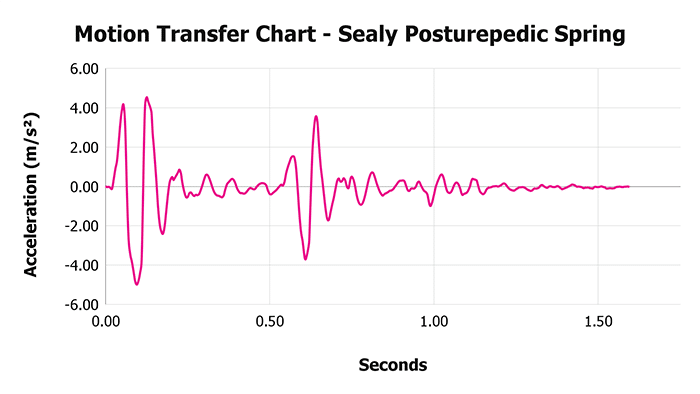
The mattress has a significant secondary energy spike and a motion duration that extends far beyond the average duration. Nevertheless, given the fact the motion peaks were still within the low range, it’s hard to complain too much.
Response Test
The Sealy Posturepedic Spring has an extremely fast mostly recovered response time and a very fast fully recovered response time.
Mostly Recovered
0.2 sec.
Complete Recovery
0.6 sec.
In our mostly recovered test, we measured a recovery speed of 0.2 seconds, which is 0.20 seconds faster than the average of 0.40 seconds, based on all of our tests to date.
In our fully recovered responsiveness test, we measured a recovery speed of 0.6 seconds, which is 0.30 seconds faster than the average of 0.90 seconds.
The level of responsiveness is documented in the video below.
While these responsiveness speeds aren’t the fastest we’ve tested, they are still plenty fast enough to make the mattress easy to move around on and avoid any type of a stuck feeling. I expect most sleepers will find response at these levels to be sufficient.
Bounce Test
The Sealy Posturepedic Spring has a moderate level of bounce. During our tests, we measured a total bounce height of 9.68″. This is 0.17″ more bounce than the average of 9.51″, based on all of our tests to date.
Max. Depth
5.17″
Max. Rebound
4.51″
Total Bounce
9.68″
Max. Sinkage Depth
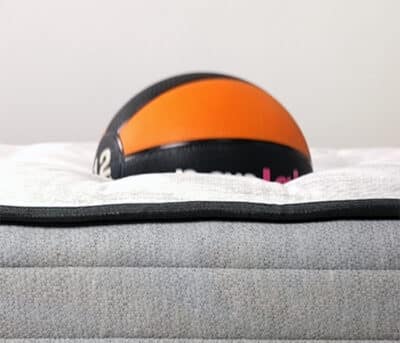
Max Bounce Height
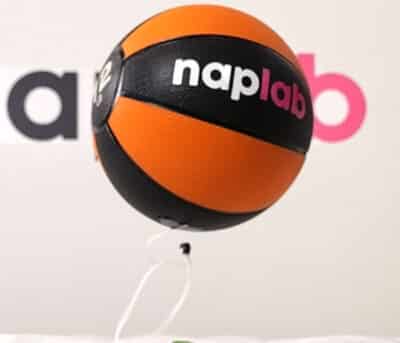
The level of bounce is also documented in the video below.
Spring and coil mattresses typically have more bounce and that’s exactly what we measured with this mattress. The limited 3.5” comfort layer and 7.0” spring unit work together to create a higher-than-average level of bounce.
Ideally, I want to see 8-12″ of total bounce height. The Sealy Posturepedic Spring is right in the middle of that range. This creates plenty of bounce to facilitate ease of movement and amorous activity.
Edge Support Test
The Sealy Posturepedic Spring has excellent sitting and lying edge support.
Max. Sinkage
3.25″
Lying Support
Excellent
Reinforced Edge
Yes
In our sitting edge support test, we measured a sitting sinkage compression of 3.25″. This is 0.79″ less sitting sinkage than the average of 4.04″, based on all of our tests to date. Even when sitting directly on the edge of the mattress I felt fully supported.
The level of edge support while seated is documented in the images below.
Sitting, 140 lbs.
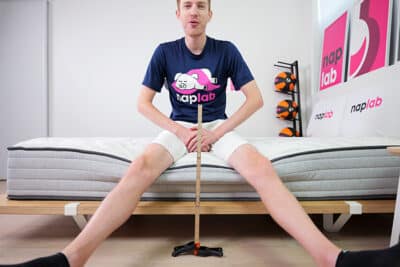
Sitting, 200 lbs.
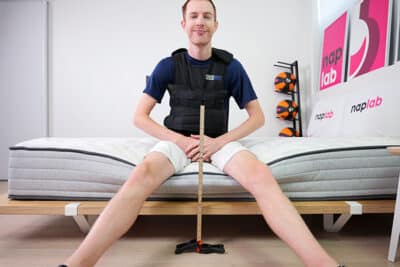
Having a more limited 3.5” comfort layer definitely helps to create more robust support at the edge.
While lying directly on the edge of the mattress, I felt that the support was excellent in all sleeping positions.
The level of edge support while lying is documented in the images below.
Lying on Edge, 140 lbs.
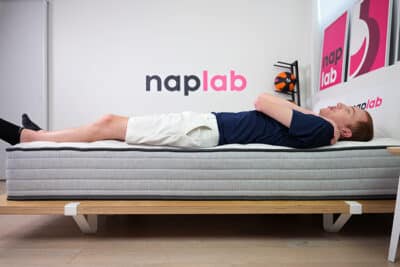
Lying on Edge, 200 lbs.

The Posturepedic Spring uses two rows of reinforced coils that run along the perimeter of the mattress. Those coils are having a notable impact for both sitting and lying edge support.
Overall, I’m pleased with the level of edge support performance and expect it will be a non-issue for most sleepers.
Sex Test
The Sealy Posturepedic Spring has good sex performance. On the positive side, bounce is high and edge support is excellent.
The mattress has a total bounce height of 9.68”, which is 0.17” more than the average. The increased bounce is the greatest single factor in helping to improve amorous activity performance.
| Sex Factor | Factor Weight | Score | Rating |
|---|---|---|---|
| Bounce | 65% | 8.5 | High |
| Edge Support | 20% | 9.7 | Excellent |
| Noise | 5% | 8.0 | Moderate |
| Pressure Relief | 5% | 5.0 | Poor |
| Cooling | 5% | 5.0 | Poor |
In addition, sitting edge sinkage is also better than average with just 3.25” of sitting sinkage. This helps to extend the usable surface of the mattress. That said, it’s not all good news.
On the negative side, noise is moderate due to the relative quality of the materials and coil unit, pressure relief is poor, and cooling is also poor.
Certainly, the increased noise makes it more difficult for stealthy sessions.
In addition, the worse pressure relief and cooling can simply make the experience less comfortable.
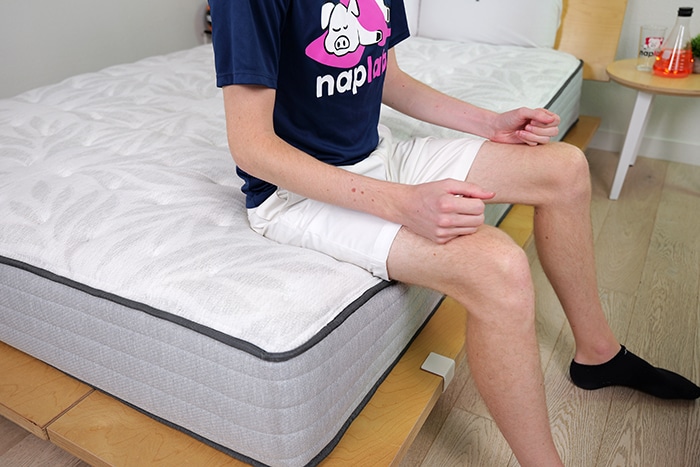
All that said, because bounce and edge support performed well the mattress still earned a good score. Even so, it still leaves much to be desired with respect to comfort.
Pressure Relief Test
The Sealy Posturepedic Spring has a poor level of pressure relief. During our tests, I felt significant pressure points on my body.
Comfort Layer
3.5″
Support Layer
8.0″
The mattress is equipped with 3.5″ of comfort material. This means there is 0.61” less comfort material than the average comfort layer thickness of 4.11″, based on all of our tests to date.
In addition to simply having less comfort material than average, the quality of the comfort materials in the mattress leaves much to be desired. Overall, the foams simply don’t look especially high quality.

The foams already feel quite dried out (similar to how foams can feel after many years of use), don’t feel good on the body or in hand, and have a noticeable “crunchiness” to them when they are compressed.
We’ve tested other Sealy mattresses with a foam that feels the same (or at least similar) and experienced similarly disappointing pressure relief on those mattresses (which include the Sealy Posturepedic Hybrid, Sealy Posturepedic Plus RidgeCrest II, and Sealy Posturepedic Carver).
In my view, the combination of limited comfort material and relatively low quality of the foams make for a mattress that simply is not comfortable.
When I consider the material thickness, material quality, and my subjective experience with the mattress, I’m confident most sleepers will find the pressure relief to be poor.
Pressure Map – Side Sleepers
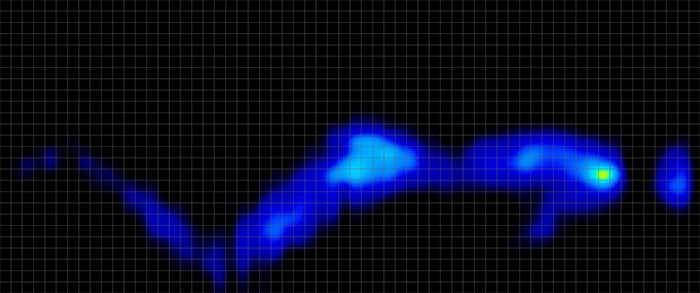
| Pressure Relief (PSI) | Average | Maximum |
|---|---|---|
| Side Sleepers | 0.18 | 1.31 |
Pressure Map – Back Sleepers
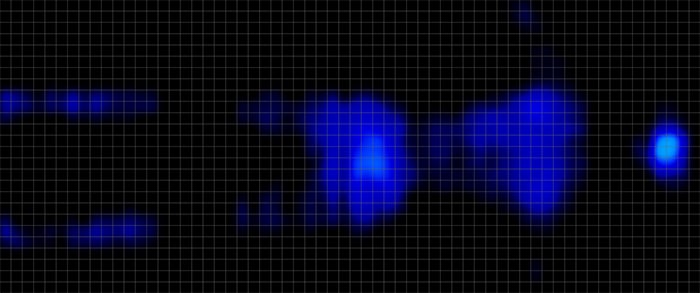
| Pressure Relief (PSI) | Average | Maximum |
|---|---|---|
| Back Sleepers | 0.10 | 0.66 |
Pressure Map – Stomach Sleepers
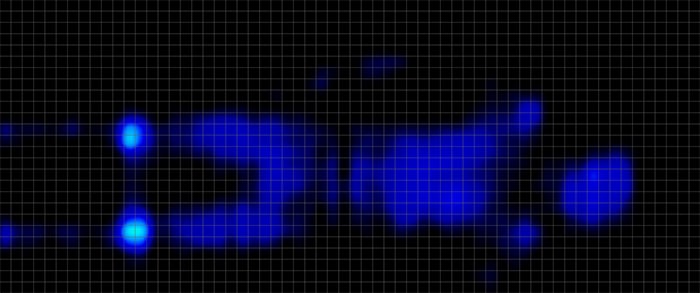
| Pressure Relief (PSI) | Average | Maximum |
|---|---|---|
| Stomach Sleepers | 0.10 | 0.95 |
Off-Gassing Test
Off-gassing on the Sealy Posturepedic Spring was strong right out of the bag and the odor lasted for 3 days.
Initial Smell Strength
Strong
Off-Gassing Period
3 days
This mattress ships uncompressed and, instead, arrives in a plastic bag the size of the full mattress.
We’ve tested over 270+ mattresses to date and of those mattresses, the majority ship vacuum-sealed and rolled into a box. The average off-gassing period is 6 days.
Based on these results, the Sealy off-gassed 3 days faster than average.
Company
Sealy mattresses come with a 90-night trial period and a 10-year warranty. Shipping is free, but if the mattress ends up not working out, return shipping will cost of $175 out of your return.
| Company Factor | Factor Weight | Score | Data |
|---|---|---|---|
| Returns | 40% | 5.0 | $175 |
| Trial Period | 30% | 6.0 | 90 nights |
| Warranty | 20% | 8.0 | 10 years |
| Shipping | 10% | 10 | $0 |
| Country of Origin | 0% | USA |
Comparing Sealy to over 80+ brands tested to date, Sealy struggles in many areas. The trial and warranty are both shorter than average.
For reference, the average trial is 177 nights and the average warranty is 13 years (excluding 25% of all mattresses that had a lifetime warranty).
Looking at 270+ mattresses tested to date, 80% offer free returns, 17% have paid returns, and 3% do not allow returns at all.
How firm is Sealy Posturepedic Spring?
The Sealy Posturepedic Spring comes in two firmness options—medium soft and medium.
Medium Version
We tested the medium version of this mattress. This mattress has a medium-firm feel and we rate it a 6 out of 10 on our firmness scale.

This firmness is the most popular level and is suitable for a wide range of sleepers. Although I will also note that the mattress is firmer than I expected. Most “medium” mattresses are a touch softer than the Sealy’s medium.
If you’re looking for that true medium, I’d actually recommend the “medium soft” version.
Medium Soft Version
We estimate the medium soft version to be around a 5 out of 10, if 10 is the most firm.

Support & Sleeping Positions
Support on the Sealy Posturepedic Spring is fair. During our tests, I felt well-supported. However, I also felt significant pressure points.
| Support Factor | Data |
|---|---|
| Comfort Layer | 3.5″ |
| Support Layer | 8.0″ |
| Firmness | Medium, and Medium-Firm |
| Body Contour | Slight |
| Zoned Support | Yes |
| Reinforced Edge | Yes |
For a mattress to be supportive, it must be capable of creating sufficient comfort so sleepers can lie in the same position, while also achieving a neutral spinal alignment for sleepers.
In my view, the Posturepedic Spring simply doesn’t do a great job at this. In our testing, I felt significant pressure points on my body and felt that the mattress wasn’t comfortable.
Check out the table below to see the sleeper weights and sleeping positions that would be best suited for this mattress.
| Sleeper Weight | Stomach Sleepers | Side Sleepers | Back Sleepers |
|---|---|---|---|
| Under 150 lbs. | Maybe | Maybe | Maybe |
| 150-250 lbs. | Yes | No | Yes |
| 250-300 lbs. | Maybe | No | Maybe |
The mattress is equipped with an 8.0″ support layer. This is 0.11″ thicker than the average support layer thickness of 7.89″, based on all of our tests to date. While the mattress has enough support, it wasn’t able to create enough comfort alongside support.
This makes the total support dynamic less than ideal. Based on all of my tests to date, an analysis of the materials, and my subjective experiences, I’m confident most sleepers will find support on the Sealy Posturepedic Spring is fair.
Design
The Sealy Posturepedic Spring is an 11.5″ coil mattress that comes in two firmness levels. It is designed to be a 12″ thick mattress, but falls a little short of that from our measurements.
| Design Factor | Data |
|---|---|
| Type | Coil |
| Thickness | 11.50″ |
| Cover Type | Pillow Top |
| Weight | 100 lbs. |
| Has Handles | Yes |
| Fiberglass-Free | Yes |
| Ships in a Box | No |
The Sealy Spring is an extremely budget-friendly mattress, priced significantly below average, aimed at sleepers on a tight budget who like the feel of traditional coil mattresses.
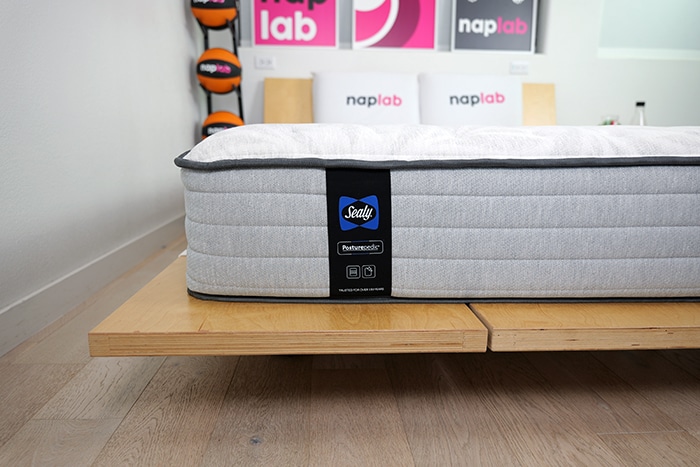
Materials
The Sealy Posturepedic Spring mattress is made up of four layers. From top to bottom, the layers include:
| Layer Type | Thickness | Layer Specs |
|---|---|---|
| Pillow Top | 2.0″ | Not Available |
| Poly Foam | 1.5″ | Not Available |
| Coil Unit | 7.0″ | Not Available |
| Support Foam | 1.0″ | Not Available |
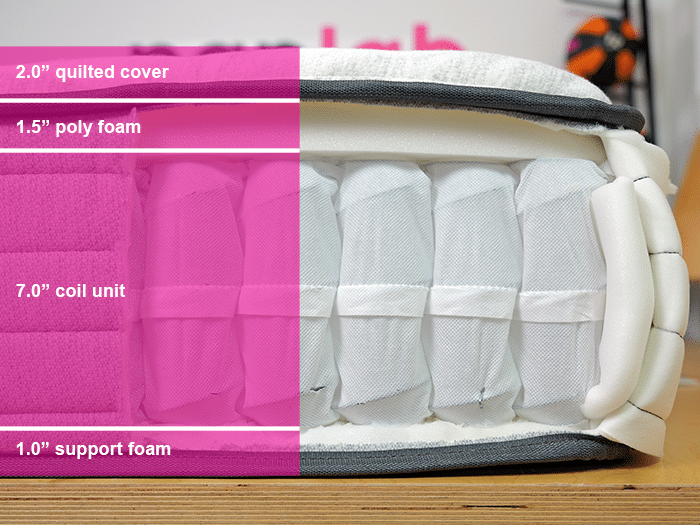
The Law Tag outlines the full breakdown of materials included in this mattress.
- Materials
- 79% polyurethane foam pad
- 99% Polyurethane
- 1% Liquid gel
- 21% Blended Fiber Batting
- 80% Rayon
- 20% Polyester
- Innerspring unit
- 79% polyurethane foam pad
- Made by: Sealy Mattress 125 S. 67th Ave Ste 150 Phoenix, AZ 85043
- Manufactured By: Sealy Mattress 125 S. 67th Ave Ste 150 Phoenix, AZ 85043
- Manufactured Date: 09/2024
- Date of Delivery: Left Blank
- Finished Size: 60” X 79”
- Net Weight Of Filling Mat: 74lbs.
- Made In: USA
- Model: 527765
- Prototype ID: LX04
The Cover
The cover of the mattress is a 2.0″ plush quilted cover with a convoluted poly foam. The top fabric is thin and stretchy and has tufted accents to hold the cover taut against the top of the mattress.

The sides of the mattress lack any handles or other special features, but the fabric is thicker than the fabric used on the top. This helps with durability and extends the overall lifespan of the mattress.
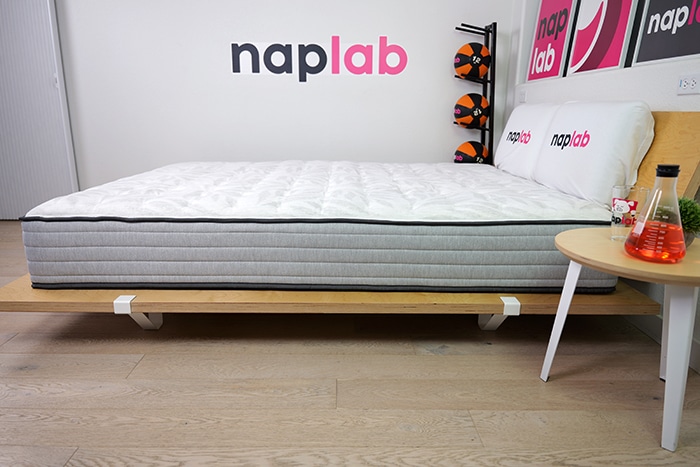
The Comfort Layer
The comfort layer of the Sealy Spring mattress is a 1.5″ poly foam. This is thinner than the average 4.1″ comfort layer, but the 2.0″ quilted cover certainly helps.
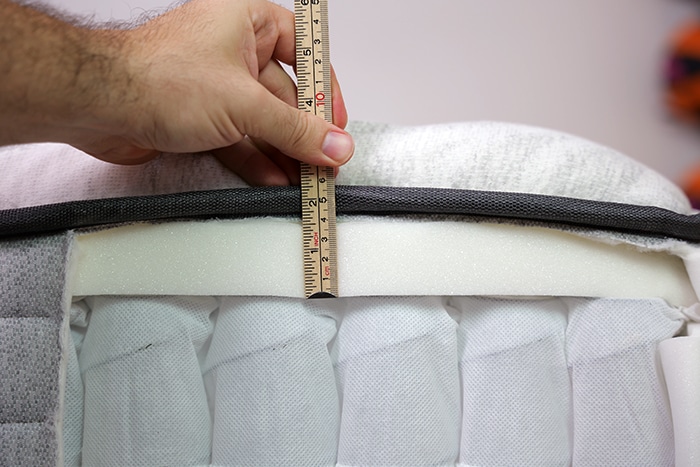
Despite the cover, this mattress struggled to provide good pressure relief during our tests and the quality issues of the comfort layer is likely the culprit of its poor performance.
The Support Layer
Beneath the poly foam is a 7.0″ coil unit. While Sealy doesn’t disclose the exact gauge or count of these coils, the performance tests reveal some issues with support.
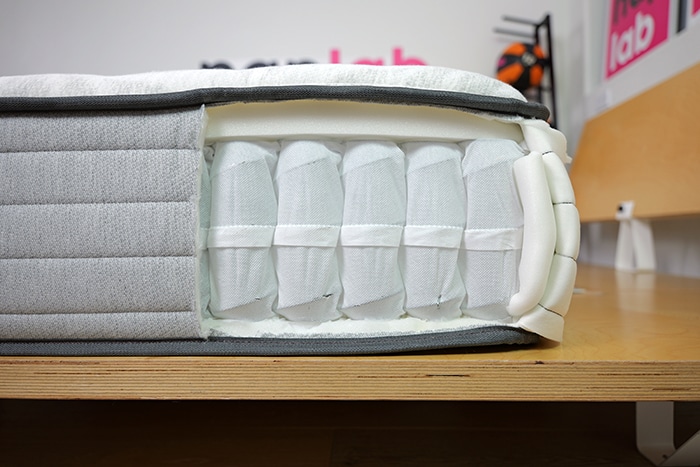
Product Evolution
The Sealy Posturepedic Spring mattress was released around 2018. Since it launched, there have been no known material or design changes made to the mattress.
That said, the Sealy has been making similar spring mattresses for decades. This is merely the more recent generation of their budget-friendly spring mattress.
Other Mattresses to Consider
Not sure if the Sealy Posturepedic Spring is the right pick for you? Check out these three other top-rated coil or hybrid mattresses for alternatives you may want to consider.
For Performance
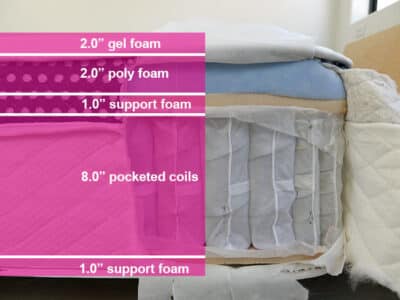
Winkbed
#1 Top Pick
The Winkbed is a 14″ hybrid mattress and although it’s technically not a coil mattress, it does have a pocketed coil base and foam comfort layer with a similar feel (deep sinkage and moderate levels of bounce). The price is higher, but considering over 270+ mattresses tested to date, Winkbed is #1.
For Value

Nectar Hybrid
Medium-Firm Hybrid
The Nectar Hybrid is a 12″ hybrid with deep sinkage, moderate bounce, and a medium-firm feel (6). It is slightly more than the Sealy, $799 for a queen, but not a huge difference, and offers his performance advantages.
For Budget
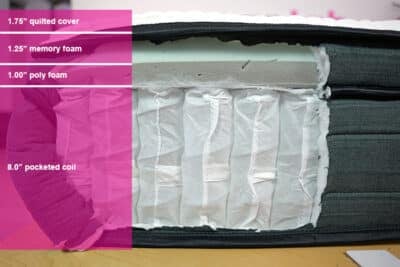
SweetNight Twilight
Foam Comfort Layer
The SweetNight Twilight is a 12″ hybrid with a budget price of only $429 for a queen mattress. Again, this isn’t a coil mattress but it does have pocketed coil support and a foam comfort layer. This isn’t the best hybrid we’ve tested, but compared to Sealy it’s a huge improvement.
Frequently Asked Questions
Still have questions? Check out some of the top FAQs on the Sealy Posturepedic Spring mattress below and get the answers you’re looking for.
Here are the current prices, with any sales or promotions reflected below:
Twin: $524
Twin XL: $559
Full: $559
Queen: $599
King: $849
Cal. King: $849
*Note: Sales prices are subject to change without notice or warning.



